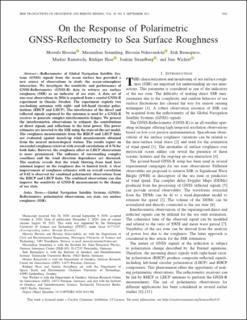| dc.contributor.author | Hoseini, Mostafa | |
| dc.contributor.author | Semmling, Maximilian | |
| dc.contributor.author | Nahavandchi, Hossein | |
| dc.contributor.author | Rennspiess, Erik | |
| dc.contributor.author | Ramatschi, Markus | |
| dc.contributor.author | Haas, Rüdiger | |
| dc.contributor.author | Strandberg, Joakim | |
| dc.contributor.author | Wickert, Jens | |
| dc.date.accessioned | 2022-03-08T08:18:13Z | |
| dc.date.available | 2022-03-08T08:18:13Z | |
| dc.date.created | 2020-12-22T16:36:18Z | |
| dc.date.issued | 2021 | |
| dc.identifier.citation | IEEE Transactions on Geoscience and Remote Sensing. 2021, 59 (9), 7945-7956. | en_US |
| dc.identifier.issn | 0196-2892 | |
| dc.identifier.uri | https://hdl.handle.net/11250/2983625 | |
| dc.description.abstract | Reflectometry of Global Navigation Satellite Systems (GNSS) signals from the ocean surface has provided a new source of observations to study the ocean-atmosphere interaction. We investigate the sensitivity and performance of GNSS-Reflectometry (GNSS-R) data to retrieve sea surface roughness (SSR) as an indicator of sea state. A data set of one-year observations in 2016 is acquired from a coastal GNSS-R experiment in Onsala, Sweden. The experiment exploits two sea-looking antennas with right- and left-hand circular polarizations (RHCP and LHCP). The interference of the direct and reflected signals captured by the antennas is used by a GNSS-R receiver to generate complex interferometric fringes. We process the interferometric observations to estimate the contributions of direct signals and reflections to the total power. The power estimates are inverted to the SSR using the state-of-the-art model. The roughness measurements from the RHCP and LHCP links are evaluated against match-up wind measurements obtained from the nearest meteorological station. The results report on successful roughness retrieval with overall correlations of 0.76 for both links. However, the roughness effect in LHCP observations is more pronounced. The influence of surrounding complex coastlines and the wind direction dependence are discussed. The analysis reveals that the winds blowing from land have minimal impact on the roughness due to limited fetch. A clear improvement of roughness estimates with an overall correlation of 0.82 is observed for combined polarimetric observations from the RHCP and LHCP links. The combined observations can also improve the sensitivity of GNSS-R measurements to the change of sea state. | en_US |
| dc.language.iso | eng | en_US |
| dc.publisher | IEEE | en_US |
| dc.relation.uri | https://ieeexplore.ieee.org/document/9246578/metrics#metrics | |
| dc.rights | Navngivelse 4.0 Internasjonal | * |
| dc.rights.uri | http://creativecommons.org/licenses/by/4.0/deed.no | * |
| dc.title | On the Response of Polarimetric GNSS-Reflectometry to Sea Surface Roughness | en_US |
| dc.type | Journal article | en_US |
| dc.type | Peer reviewed | en_US |
| dc.description.version | publishedVersion | en_US |
| dc.source.pagenumber | 7945-7956 | en_US |
| dc.source.volume | 59 | en_US |
| dc.source.journal | IEEE Transactions on Geoscience and Remote Sensing | en_US |
| dc.source.issue | 9 | en_US |
| dc.identifier.doi | 10.1109/TGRS.2020.3031396 | |
| dc.identifier.cristin | 1862872 | |
| cristin.ispublished | true | |
| cristin.fulltext | publishedVersion | |
| cristin.qualitycode | 2 | |

